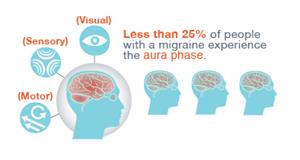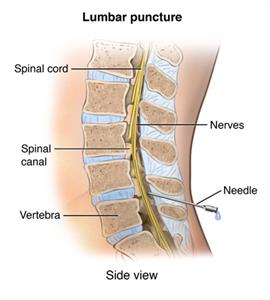What is a migraine headache?
This often severe, throbbing type of headache is different from other types of headaches in that symptoms other than pain occur with the headache. Nausea and vomiting, lightheadedness, sensitivity to light (photophobia), and other visual disturbances are common migraine symptoms. A migraine headache may last from 4 to 72 hours.
Migraines are also unique in that they have distinct phases. Not all people have each phase, however. The phases of a migraine headache may include:
 Premonition phase. A change in mood or behavior that may occur hours or days before the headache.
Premonition phase. A change in mood or behavior that may occur hours or days before the headache.- Aura phase. About one-third of people who have migraine headaches describe having an unusual “feeling” or aura before the headache. The aura phase includes visual, sensory, or motor symptoms that occur just before the headache. Examples include hallucinations, numbness, changes in speech, visual changes, and muscle weakness. Migraine sufferers may or may not have an aura before the beginning of the headache.
- Headache phase. This is the period during the actual headache. Throbbing pain occurs on one or both sides of the head. Sensitivity to light and motion is common, as are depression, fatigue, and anxiety.
- Headache resolution phase. Pain lessens during this phase, but may be replaced with fatigue, irritability, and trouble concentrating. Some people feel refreshed after an attack, while others do not.
Headaches are classified as with or without aura.
What causes migraine headaches?
Experts are not certain what causes a migraine headache. Many experts think an imbalance in brain chemicals, such as serotonin, and changes in nerve pathways are involved. Migraines may also run in families suggesting a genetic link.
What are the symptoms of migraine headaches?
To get an accurate diagnosis, it is important to describe your migraine symptoms to your doctor. Also, it is helpful to track when migraines occur (such as dates and times) and the details associated with migraine headaches. These are the most common symptoms of migraine headaches:
- Throbbing, severe headache pain with a specific location either on one side or another
- Nausea and vomiting, lightheadedness, sensitivity to light may also occur during a migraine
- Visual disturbances, even lack of sight, may occur for a short period of time with a migraine headache
- A change in mood or behavior that may occur hours or days before the headache
- Depression, fatigue or anxiety may occur
- As the headache resolves, you may notice fatigue, irritability, and trouble concentrating
- Some headaches have an aura before a migraine, which may be experienced as a flashing light or other visual changes
The symptoms of migraine headache may look like other conditions or medical problems. Always see your healthcare provider for a diagnosis.
How are migraine headaches diagnosed?
Migraine headaches are diagnosed based on your symptoms and a physical exam. You may need other tests or procedures to rule out underlying diseases or conditions.
Tracking and sharing information about your headache with your doctor helps with the process of making an accurate diagnosis. Consider writing down the following information to take to your medical appointment:
- Time of day when your headaches occur
- Specific location of your headaches
- How your headaches feel
- How long your headaches last
- Any changes in behavior or personality
- Effect of changes in position or activities on the headache
- Effect of headaches on sleep patterns
- Information about stress in your life
- Information about any head trauma, either recently or in the past
Diagnostic tests that may be used to confirm a migraine diagnosis include the following:
- Blood tests. Various blood chemistry and other lab tests may be used to check for underlying conditions.
- Sinus X-rays. An X-ray to evaluate for congestion or other problems related to the headaches.
- MRI. A diagnostic procedure, usually of the head or neck, that uses a combination of large magnets, radiofrequencies, and a computer to produce detailed images of organs and structures
- CT scan or computed tomography scan. A diagnostic imaging procedure that uses X-rays and computer technology to make horizontal, or axial, images (often called slices) of the body or head. CT scans show more detail than standard X-rays.
- Spinal tap (also called a lumbar puncture). A special needle is placed into the lower back, into the spinal canal, which is the area around the spinal cord. The pressure in the spinal canal and brain can then be measured. A small amount of cerebral spinal fluid (CSF) can be removed and sent for testing to determine if there is an infection or other problems. CSF is the fluid that surrounds the brain and spinal cord.

How are migraine headaches treated?
Specific treatment for migraine headaches will be determined by your healthcare provider based on:
- Your age, overall health, and medical history
- Type of migraine
- Severity and frequency of the migraine
- Your tolerance for specific medications, procedures, or therapies
- Your opinion or preference
Certain medicines can help treat or prevent migraine headaches:
- Abortive medicines. Medicines, prescribed by your doctor, that act on specific receptors in both the brain and the blood vessels in the head, stopping a headache once it is in progress.
- Rescue medicines. Medicines purchased over-the-counter, such as pain relievers, to diminish or stop the headache.
- Preventive (prophylactic) medicines. Medicines prescribed by your doctor that are taken daily to suppress the onset of severe migraine headaches.
What are the complications of migraine headaches?
Complications of migraine headaches may include:
- Severe headache pain, often in one part of your head, such as near one eye
- Potential nausea and vomiting
- Immobility and lack of activity due to severe pain
- Loss of work time and personal time
Can migraine headaches be prevented?
The goal of treatment is to prevent migraines from occurring. Good management depends on an accurate diagnosis and:
- Avoiding known triggers, such as certain foods and beverages, caffeine, lack of sleep, and fasting
- Changing eating habits
- Getting regular exercise
- Resting in a quiet, dark environment
- Taking medicines, as recommended by your doctor
- Managing stress
- Getting therapeutic massage
- Taking prescribed medicine when you have an aura
When should I call my healthcare provider?
Some headaches may require immediate medical attention, including hospitalization for observation, and diagnostic testing. Call your healthcare provider right away if a migraine headache is accompanied by:
- Stiff neck
- Fever
- Convulsion
- Shortness of breath
- Confusion
- Muscular weakness
- Double vision
- Change in level of consciousness
Key points about migraine headaches
- A migraine is a severe, throbbing type of headache.
- Nausea and vomiting, lightheadedness, sensitivity to light (photophobia), and other visual disturbances are common migraine symptoms.
- A migraine headache may last from 4 to 72 hours.
- Preventing a migraine headache is often the most effective approach for treatment.
- Migraine headaches can have a predictable pattern that can help you recognize and treat them appropriately.
- Many people have an aura prior to a migraine and intervention may help at that time.
- Managing stress and getting regular exercise may help prevent or lessen the occurrence of migraine headaches.
Next steps
Tips to help you get the most from a visit to your healthcare provider:
- Know the reason for your visit and what you want to happen.
- Before your visit, write down questions you want answered.
- Bring someone with you to help you ask questions and remember what your provider tells you.
- At the visit, write down the name of a new diagnosis, and any new medicines, treatments, or tests. Also write down any new instructions your provider gives you.
- Know why a new medicine or treatment is prescribed, and how it will help you. Also know what the side effects are.
- Ask if your condition can be treated in other ways.
- Know why a test or procedure is recommended and what the results could mean.
- Know what to expect if you do not take the medicine or have the test or procedure.
- If you have a follow-up appointment, write down the date, time, and purpose for that visit.
- Know how you can contact your provider if you have questions.












